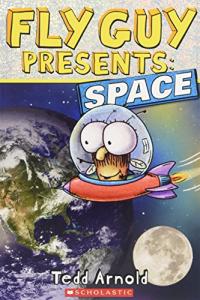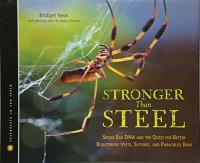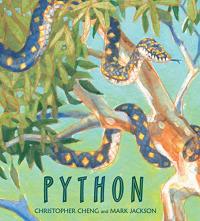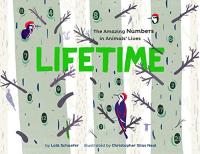
Buzz and his pet fly, Fly Guy, visit a space museum for a brief introduction to stars, planets and related concepts. Photographs and funny illustrations combine with easy-to- read language for a quick, accessible, informative trip shared by old friends.
Fly Guy Presents Space

A vacationing family sees many different types of boats and ships as well as what they carry. Young readers will find lots to explore as they travel over the waters in this large, highly pictorial journey.
Everything Goes by Sea

From his early childhood in Jamaica, Clive loved all types of music. When he was 13 years old, he moved to New York where his affinity for music blossomed. Ultimately Clive, now Cool Herc, achieved his dream of being surrounded by music as a DJ and started a new music form. Angular illustrations and informative back matter complete this portrait of music and a musician.
When the Beat Was Born: DJ Kool Herc and the Creation of Hip Hop

Word problems run in Robert’s family. When his grandma told him about anagrams, “different words (even phrases and sentences) that have exactly the same letters,” he just couldn’t get away from them! Playful illustrations and varied typeface add to the wordplay fun.
Ann and Nan Are Anagrams

Everyone knows what a toilet is, but have you ever wondered what happens when a toilet is flushed? A brief introduction explains why toilets are needed (the digestive system), followed by lucid text and clear illustrations, with humorous touches, that detail what happens. This glimpse is sure to engage and heighten appreciation for the toilet.
Toilet: How it Works

The natural world is filled with frightening creatures that titillate, amaze and awe. Characteristics (size, “weapons” and skills) of 100 of them are presented in dramatic, full- color photographs and factoids. This installment of the series may inspire readers to find out more about the enthralling range of critters.
100 Most Feared Creatures

Mummies and mummification in North America are introduced in short, readable text accompanied by illustration and photographs. Adapted from her longer book, the easy reader format makes a fascinating topic accessible to newly independent readers.
Mummy Mysteries: Tales from North America

Also see Discover More Reptiles (opens in a new window) from the same author. Questions, tidbits of information and full-color photographs all in an appealing format are perfect to dip and out of for information about the subjects in this series. Each title includes a table of contents, an index and even a glossary of words plus the potential to find out more online.
Discover More Weather

A group of movie-making monsters introduce the concepts needed to make a 3-dimensional film: width, height, depth. Related ideas and vocabulary follow (e.g., circumference, area, etc.) also presented with the same light touch. Flat, silly-but-colorful monsters lead the exploration to its conclusion.
Perimeter, Area and Volume: A Monster Book of Dimensions

A billion is a big number, bigger than a million. “It’s written like this: 1,000,000,000 — one followed by nine zeroes.” There aren’t even that many hairs on your head! Colorful illustrations and child-friendly comparisons bring these huge numbers into clearer focus in both words and numerals enhanced by bright, cheery illustrations.
Millions, Billions and Trillions: Understanding Big Numbers

Colorful toy teddy bears appear on open pages with an engaging, rhyming narrative. Children will be able to see the patterns and learn to “skip count” (e.g., counting by 2s) while being introduced to basic arithmetic (addition and its relationship to multiplication). One of a series of basic math books.
Teddy Bear Patterns

Math is all around when the Bird brothers, Woody, Willy, Wilmer, Wendell and Walter compete at games, eat hot dogs, and ride the Ferris wheel at a carnival. Comic illustrations combine with words and numerals to highlight the brothers’ alliterative tale while illuminating basic math concepts.
The Wing Wing Brothers: Carnival de Math

Intriguing questions introduce the notion of possibility and its opposite which leads to the introduction of mathematical probability. Activities and games to test the chances of something happening involve coins, cards and more to bring the concepts into clear, recognizable and highly appealing focus.
That’s a Possibility: A Book About What Might Happen

Simple rhymes combine with crisp, uncluttered photographs to ask (and answer visually as well as with numerals) simple questions that are answered with subtraction. Number sentences (e.g., 8 - 2=6) are also included for each as are clever asides or additional information on each double page spread.
Help Me Learn Subtraction

Paul Erdos grew up in Hungary and was always an unusual child. He enjoyed numbers, was inept at everyday activities (like tying his shoes), and hated rules but grew up to be a famous mathematician. Witty illustrations and a fluid narrative (which imbeds mathematical language), and fascinating author and illustrator notes introduce this mathematically gifted man.
The Boy Who Loved Math: The Improbable Life of Paul Erdos

Math is not only all around but everyday goings-on make thinking mathematically fun. Activities of varying difficulty (wee ones, little kids, big kids) use the familiar — from dogs to ketchup — to present intriguing math questions to solve, all humorously illustrated. Answers are discreetly placed on each page with additional information for adults at the end.
Bedtime Math

Charles Darwin came across a distinctive frog in Chile during his ventures on the Beagle. The exceptional characteristics and the mysteries it created are presented in engaging text, photographs and notable, realistic collage illustrations. Additional resources are included.
The Mystery of Darwin’s Frog

The strength of Spiderman’s web wasn’t far from reality. Biologist Randy Lewis’ work proves it. A highly readable text and captivating photographs make a complicated topic, related issues, and current research understandable for sophisticated readers of all ages.
Stronger than Steel

Like most snakes, pythons are often vilified. Realistic watercolors, however, of a Diamond Python (native to Australia) and informative text present a slice of her life from warming in the sun to hatching eggs — and, of course hunting and eating.
Python

Interesting factual tidbits inspired imaginative animal portraits. The strong graphic design on large pages encourages close reading so that “while the creatures …may look a little silly, they are all based on real animal facts.”
Paul Thurlby’s Wildlife

Meet different kinds of monkeys — all of which come in many colors — shown in crisply lined, full-color illustration and brief text. Additional information about each of the 12 monkeys introduced and a world map concludes this brief, enticing introduction.
Monkey Colors

In one lifetime, creatures presented will grow or show one behavior repeatedly. Limited text combines with textured illustration to reveal these estimates from one papery spider egg sac to a thousand baby seahorses. Animal and math information conclude this unique glimpse of animals.
Lifetime: The Amazing Numbers in Animal Lives

Meet a panda, moon bear, sloth bear, sun bear, and other kinds (plus a teddy bear) in simple rhyming text and gentle illustrations. Bear facts and where to find additional information conclude this easy informational picture book.
If You Were a Panda Bear

Rhythmic text and lush illustrations invite young readers (or listeners) to eat like a bear from April until midwinter. Textured illustrations and more thorough backmatter conclude this engaging introduction to brown bears and their habitat.
